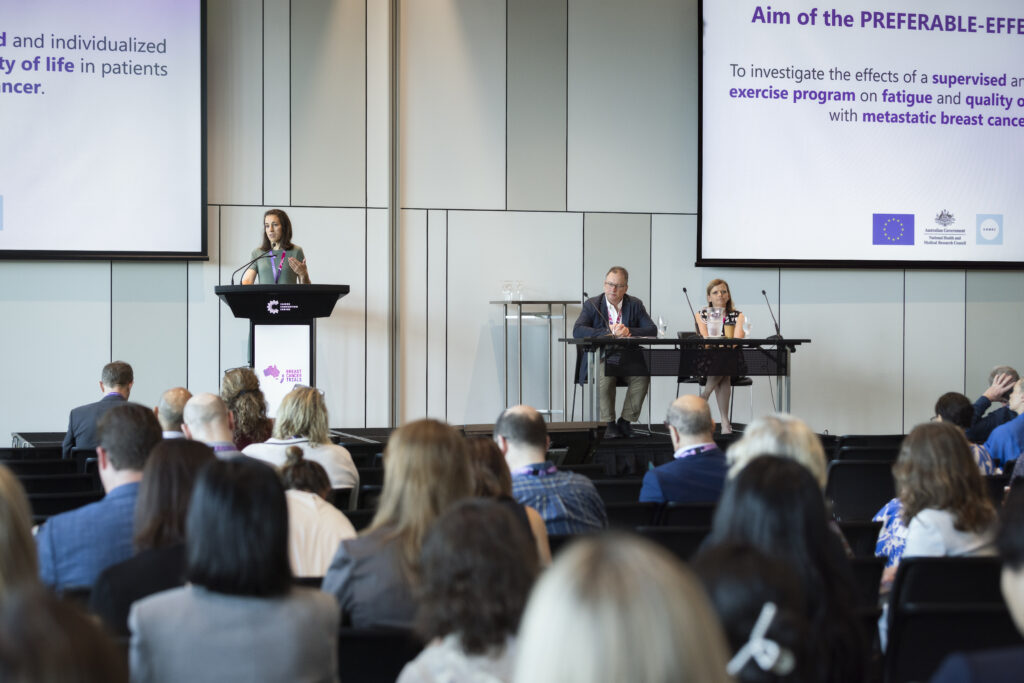About Exercise Physiologist Dr Eva Zopf
Dr Eva Zopf is an exercise physiologist whose research interest focuses on the role of exercise as medicine for the management of cancer. Aside from developing, conducting and evaluating exercise intervention studies in cancer patients, Eva is also dedicated to improving the supportive care services available for cancer survivors.
We spoke with her about the PREFERABLE-EFFECT study and the role of structured exercise in metastatic breast cancer and quality of life outcomes.
What are the effects of exercise on fatigue and quality of life?
Background to the PREFERABLE-EFFECT Study
“So, we actually decided to run this trial because there’s been quite a lot of evidence around the beneficial effects of exercise in cancer patients. But most of the studies that have been conducted to date have looked at patients that have localised disease or have been treated with curative intent, and so there’s actually not a lot of evidence in patients who have metastatic disease.”
“So, the aim of this project was to look at the effects of exercise on fatigue and quality of life in patients with metastatic breast cancer. And the reason being that those patients often have ongoing treatment. They have a higher symptom burden generally than patients that have localized disease.”
“So, for those that finish their treatment in a localised setting their symptoms might subside after a few years. We do know that those that have ongoing treatment, the symptom burden will increase, or is more likely to increase over time, so we wanted to figure out if exercise is also beneficial and safe for those patients.”
Listen to the Podcast
We spoke to Dr Eva Zopf about the PREFERABLE-EFFECT study and the role of structured exercise in metastatic breast cancer and quality of life outcomes.
“What we did first of all, was divide the group, or the study participants up into two groups. So, we had one group that received breast cancer exercise advice and a physical activity tracker. The other group received that as well, but they also received a structured exercise program. So that consisted of two supervised exercise sessions for the first six months, and it was reduced to one supervised exercise session for the last three months.”
Exercising safely in structured exercise sessions resulted in:
1. Reduced fatigue
“The sessions included aerobic training, like riding on a bike or walking on a treadmill, and resistance training to improve muscle mass and also some balance training. And what we found is that the group that participated in the intervention study, so had that structured exercise program, they had higher quality of life outcomes than the participants in the control group, and they also had lower levels of fatigue.”
2. Lower pain levels and decreased shortness of breath
“So those were our two primary endpoints that we wanted to look at. We looked at a number of other outcomes, for example some of the symptoms that are quite common in patients with metastatic breast cancer like pain and dyspnoea. We also saw that the patients in the intervention group actually had lower pain levels throughout the entire intervention period of nine months and also lower levels of dyspnoea. Dyspnoea is shortness of breath, which is also quite commonly reported.”
3. Better sexual functioning
“In addition, we looked at some of the breast cancer specific symptoms or side effects like reduced sexual functioning and we saw that the intervention group also had better sexual functioning than the control group and the same applied to some of the endocrine sexual symptoms that some of the patients experienced from endocrine treatment.”
Breast cancer exercise recommendations
1. Aerobic training and vigorous activity
“So, we did a combined program so our exercise program consisted of aerobic training, which is more cardiorespiratory training, that improves blood circulation through your heart function. For example, that can be running, cycling, swimming, and so forth. We didn’t offer swimming, but just as an example of aerobic training.”
2. Resistance training and muscle-strengthening activity
“Resistance training, which is a type of weight training, which generally improves your muscle mass and balance training, which can also obviously improve balance, but we know with some patients who receive chemotherapy and when neuropathies are an issue, that can help in those terms as well.”
3. General exercise advice for breast cancer patients
“We compared that to our control group that just received exercise advice. So, the general advice for cancer patients is to be physically active for about 150 minutes per week. So, participants received an activity tracker. And given we saw better improvements or better quality of life and lower fatigue in the intervention group, we do feel like that just providing exercise advice might be enough.”
“But that really structured and supervised exercise program, where in our case it was two supervised sessions per week is really required to maximize the benefits that you can get from exercising.”
Recommendation: Supervised resistance and aerobic exercise for patients with metastatic breast cancer.
“Based on the results that we found from the trial, we would definitely recommend that supervised resistance and aerobic exercise is offered to patients with metastatic breast cancer as a supportive care strategy.”
Additional benefit: decreased health care costs
“We did also did a cost effectiveness analysis to see whether it was cost effective. And so, we looked in both groups how often patients saw their GP or used other services such as how often they went to the hospital or required any other care. And we did see that those that took part in the structured exercise intervention also had lower health care costs. And so, we do think there’s a benefit of getting more support or exercise integrated as a routine component of cancer care.”
“I think there is still a little bit of a way to go to provide those services to all. But we definitely think, if possible, try to find an exercise physiologist who has experience working with cancer patients to just get support in what exercise you can be doing and to get an exercise program prescribed to you to then hopefully follow through and experience some of the benefits that the patients on our trial did.”
What are your hopes for the future of breast cancer research?
1. Improved exercise support for cancer patients
“So, for me, the reason I get out of bed every morning is to really improve the exercise support that cancer patients in general receive, whether that’s breast cancer or another cancer.”
2. Integrate exercise as a standard component of cancer care
“I think in Australia, the opportunities to see an exercise physiologist or get those rebated services are quite low. So that would be a first step to hopefully maybe increase those sessions or those consultations that you can get. But in general, I think we definitely need to find a way to integrate exercise as a standard component of cancer care.”
“And if we look at other countries, for example Germany, where I’m from, we have an oncological rehab program, similar to cardiac rehab here and that’s subsidized by the health insurance companies and that means exercise becomes more accessible.”
3. Remote access to exercise programs for breast cancer patients
“We’ve just started a new international trial, where we’re looking at Zoom-based exercise sessions, so providing a telehealth or live remote training for 12-weeks, so that we can offer the exercise program to patients that live more remotely and can’t access an exercise physiologist, and we want to see whether that’s just as effective as in person supervision.”
“And again, that the aim of that is to make exercise more accessible. At some stage, my hope is that every patient that’s diagnosed with cancer has access to exercise support.”
The Benefit of Complementary Therapies
If you liked this podcast, find out more about how a balanced diet can also be a complementary therapy to enhance wellness for those affected by metastatic breast cancer in our podcast: Optimising care for metastatic breast cancer patients through exercise and diet.
Support Us
Help us to change lives through breast cancer clinical trials research.
Support Us
Help us to change lives through breast cancer clinical trials research



